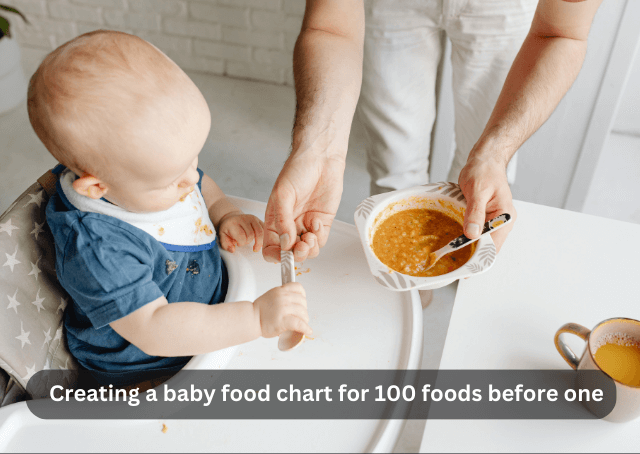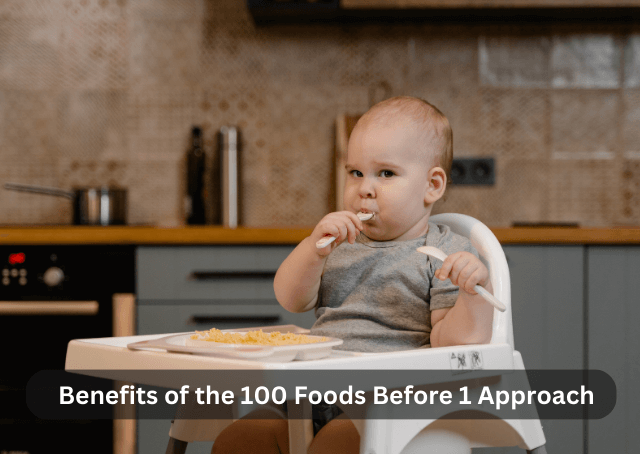Astutely Baby-Led Weaning: 100 Foods Before 1 – A Complete Guide

Astutely Baby-Led Weaning: A Guide to Introducing 100 Foods Before 1
Table of Contents
What is baby-led weaning and why is it beneficial?
Baby-led weaning is a method of introducing solid foods to babies by allowing them to feed themselves from the very beginning, rather than being spoon-fed purees. This approach promotes self-feeding and independence in babies, allowing them to explore a variety of flavors and textures at their own pace.
Introduction to baby-led weaning
Baby-led weaning is based on the belief that babies are capable of feeding themselves from the moment they start showing an interest in food. It involves offering age-appropriate foods in their whole, finger-sized form, allowing babies to pick up and eat them independently.
Benefits of baby-led weaning
Explore the Benefits of Baby-Led Weaning for Babies and Parents. Firstly, it helps babies develop their fine motor skills and hand-eye coordination as they practice picking up food. It also encourages self-regulation of appetite, as babies learn to eat until they are satisfied.
How does baby-led weaning differ from traditional weaning?
Traditional weaning typically involves starting with purees and gradually progressing to mashed and then solid foods. Baby-led weaning skips the puree stage and allows babies to explore solid foods from the beginning. It focuses on the introduction of a wide variety of foods to help babies develop a diverse palate.

When should you start solids and how to introduce them?
Recognizing the Key Signs Indicating Your Baby’s Readiness for Solids
Before starting solids, it is important to look for certain signs that indicate your baby is ready. These signs include being able to sit up with support, showing an interest in food, and being able to pick up objects and bring them to their mouth.
How to start solids with baby-led weaning
To start solids with baby-led weaning, you can offer your baby soft, finger-sized foods that are easy to grasp. Some suitable first foods include steamed vegetables, soft fruits, and well-cooked grains. Allow your baby to explore the food and encourage self-feeding.
Introducing a diverse range of foods to your infant for healthy development
One of the main benefits of baby-led weaning is the opportunity to introduce a wide variety of foods to your baby. By offering different textures and flavors, you can help develop their taste preferences and ensure they receive a balanced diet. Some examples of foods to introduce include avocado, sweet potatoes, and cooked pasta.
What are the 100 foods to introduce before 1?

Essential foods for baby-led weaning
When following baby-led weaning, it is important to offer a variety of nutrient-rich foods to ensure your baby receives all the necessary nutrients. Some essential foods to include are mashed bananas, soft-cooked carrots, small pieces of chicken, and scrambled eggs.
Creating a baby food chart for 100 foods before one
To keep track of the foods you introduce, it can be helpful to create a baby food chart. This chart can include a list of the 100 foods you aim to introduce before your baby turns one. You can check off each food as your baby tries it, ensuring they receive a diverse range of nutrients.
Printable checklist for tracking the foods introduced
If you prefer a more visual way of tracking the foods you introduce, you can use a printable checklist. Many websites offer downloadable checklists specifically designed for baby-led weaning, making it easier to keep track of your baby’s progress.
Are there any safety considerations with baby-led weaning?
Preventing choking during baby-led weaning
Choking is a concern for many parents when it comes to baby-led weaning. To minimize the risk, it is important to offer foods that are safe for babies to handle and swallow. Soft, well-cooked foods that can easily be mashed with gums are recommended. Always supervise your baby during mealtimes and be prepared to respond in case of choking.
Common allergenic foods and how to introduce them safely
When introducing potentially allergenic foods, such as nuts, dairy, and eggs, it is important to do so carefully. Start by offering a small amount and monitor your baby for any allergic reactions. Introduce one new food at a time, waiting a few days before introducing another allergenic food.
The importance of maintaining head control during mealtime
As your baby begins to explore solid foods, it is crucial to ensure they have adequate head control. This helps prevent choking and allows your baby to safely navigate their food. Make sure your baby is sitting upright and supported during mealtimes.
Tips and tricks for successful baby-led weaning
Meal planning for baby-led weaning
Meal planning can be helpful when practicing baby-led weaning. By planning meals, you can ensure your baby receives a balanced diet and a variety of nutrients. Include foods from different food groups and aim for a colorful plate.
Encouraging family food exploration with baby-led weaning

Baby-led weaning provides an opportunity for the entire family to explore new foods and enjoy meals together. Encourage family members to try new foods along with your baby and make mealtimes a positive and enjoyable experience for everyone.
Addressing common questions and concerns about baby-led weaning
As with any feeding method, baby-led weaning can raise questions and concerns for parents. It is important to seek guidance and support from healthcare professionals and other experienced parents. They offer valuable guidance and can address any concerns you might have.
Exploring the latest BLW trend: Introducing your baby to 100 foods within the first year made easy! This trend is gaining popularity among the Baby Led Weaning community. Successfully introducing 100 different foods to your baby within their first year is a significant accomplishment! Although it may appear overwhelming, it is much simpler than you realize.
To save the 100 First Foods checklist image to your phone, just press and hold the image, then click ‘Add to Photos. To save this 100 initial foods checklist image to your phone, all you need to do is hold down on it and select ‘add to photos’.
Weaning Guide: When to Introduce 100 Foods Before 1 Year – Expert Advice
When it comes to introducing solid foods to your baby, there is no set rule that says you need to introduce 100 different foods before they turn 1. While it’s important to offer a variety of foods to ensure a well-rounded diet, the focus should be on providing a balanced mix of fruits, vegetables, grains, and proteins. As your baby grows, their taste preferences will develop, so it’s more important to offer different flavors and textures rather than reaching a specific number of foods. Ultimately, the goal is to expose your baby to a wide range of nutritious foods and encourage healthy eating habits.
10 Best in Catering Food and Drink Supplier Link
FAQ
Q: What is baby-led weaning?
A: Baby-led weaning (BLW) is a method of introducing solid foods to babies. Instead of traditional purees, babies are encouraged to self-feed with finger foods from the start.
Q: When can I start baby-led weaning?
A: BLW can be started when your baby is around 6 months old and showing signs of readiness. It is important to consult your pediatrician before introducing any solid foods.
Q: How can I determine if my baby is prepared for baby-led weaning?
A: Some signs that your baby may be ready for BLW include the ability to sit up with support, showing an interest in food, and being able to bring objects to their mouth.
Q: What are some good first finger foods for baby-led weaning?
A: Some safe and appropriate first-finger foods for BLW include soft-cooked vegetables (such as sweet potato or carrot sticks), soft fruits (such as avocado or banana slices), and strips of well-cooked meat or poultry.
Q: Are there any foods I should avoid when doing baby-led weaning?
A: It is recommended to avoid foods that are choking hazards, such as whole grapes or nuts. Additionally, some experts suggest avoiding added salt and sugar in your baby’s food.
Q: Can I still breastfeed while doing baby-led weaning?
A: Yes, breastfeeding can continue while practicing BLW. Breastmilk or formula will still be the primary source of nutrition for your baby in the early months.
Q: How do I ensure my baby is getting all the nutrients they need with baby-led weaning?
A: It is important to offer a variety of healthy foods to ensure your baby is getting all the necessary nutrients. You can also continue to breastfeed or provide formula to supplement their diet.
Q: Where can I find a printable baby food chart for baby-led weaning?
A: There are many resources available online where you can find printable baby food charts for BLW. These charts can help you keep track of the foods you have introduced and monitor any potential allergens.
Q: How many different foods should I introduce to my baby with baby-led weaning?
A: The goal of BLW is to gradually introduce your baby to a wide range of foods. Many parents aim to introduce their babies to 100 different foods before they turn one year old.
Q: Can you share a baby’s first foods checklist for baby-led weaning?
A: Yes, there are several baby’s first foods checklists available online. These checklists can help you plan and organize the foods you want to introduce to your baby with BLW.



